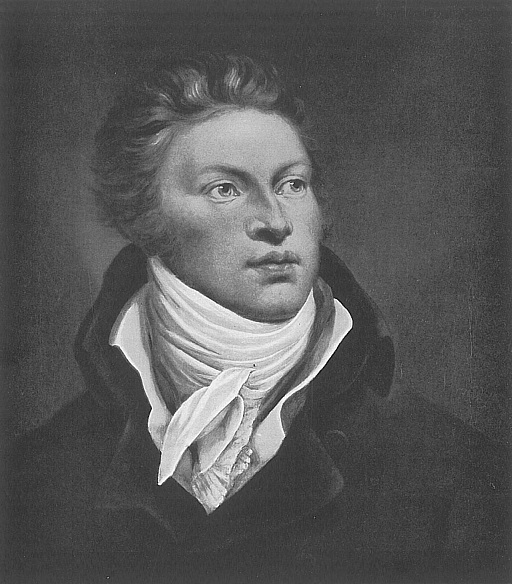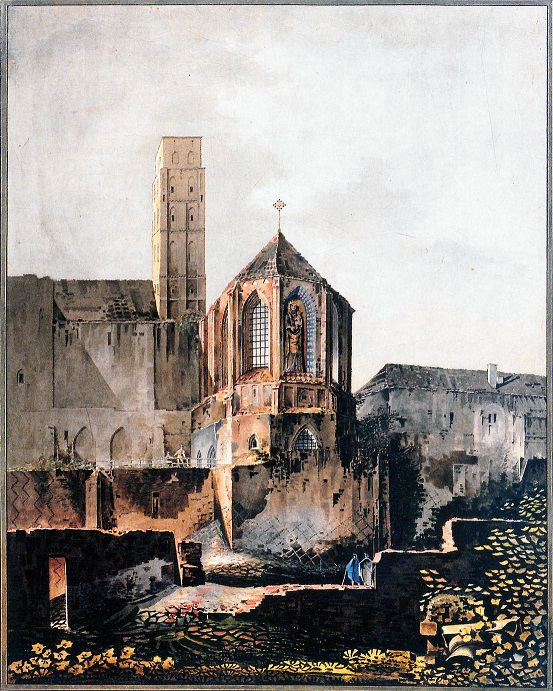Prussian architect, artist [fig. 1], educator; son of David Friedrich Gilly (1748–1808), a senior secret construction counselor at the Higher Construction Department in Berlin, promoter of the idea of simplicity and utilitarianism in architecture, who was responsible for managing construction sites in West Pomerania, in the March of Brandenburg and in the new provinces incorporated into the Kingdom of Prussia after the partitions of the Republic of Poland. Considered nowadays as one of the most outstanding architects of his era in the Berlin circle. He was born in Altdamm (Dąbie near Szczecin) in 1772. He began his education in a real school in Stargard. He showed great artistic abilities in his early childhood. From 1782 he was educated privately in Szczecin (where the Gilly family moved after his father’s promotion) in the field of drawing and engraving, learning at the same time the arcana of many building and masonry techniques. In 1787 he studied landscape painting at the Berlin studio of Friedrich Wilhelm Schaub. From 1788, he and his family settled in the capital of Prussia, where he continued his studies at the Royal Academy of Fine Arts. He studied architecture with Friedrich Becherer and with Friedrich Wilhelm Erdmannsdorff and Carl Gotthard Langhans. He learned graphic arts from Daniel Mikołaj Chodowiecki. He studied drawing and painting under Johann Gottfried Schadow, Christian Bernhard Rode, Johann Christhoph Frisch and Johann Wilhelm Meil. He was interested in both ancient art and literature, mainly in Greece, conducting independent studies in this field, as well as native Gothic architecture. He made many study trips around Europe and made many drawings documenting the appearance of architectural monuments and its details, scattered in various parts of the old continent. His main work were unfinished designs for a monument-mausoleum in honor of Frederick II Hohenzollern from 1796–1797. Together with Heinrich Moser, he managed the construction of the National Theater in Berlin, which was designed by Langhans. He prepared a design for the reconstruction of the interior in the side wing of the palace in Schwedt on the Oder for Duchess Fredericke von Mecklenburg-Strelitz. He erected the Mausoleum of Karl Georg Heinrich von Hoym in Brzeg Dolny. Gilly’s pedagogical activity influenced the development of classicism in Germany. A circle of architects gathered around him including Carl Haller von Hallerstein, Martin Friedrich Rabe, Karl Friedrich Schinkel and Joachim Ludwig Zitelmann. From 1798 he held the position of professor of optics and perspective at the newly established Building Academy in the capital of Prussia. He died in 1800, at the age of twenty-eight, of tuberculosis in Karlovy Vary (Karlsbad), where he went for treatment and was buried there in the local cemetery.
In the summer of 1794, he and his father visited the Teutonic Knights castle in Malbork. The main purpose of the trip was the preparation by David of the reconstruction of the Malbork stronghold or its possible demolition and re-use of the materials obtained from it to build a large military warehouse for grain and flour. During the painstaking work of his father, Friedrich wandered around the decaying castle complex and with youthful passion “noted” selected views of the Teutonic castle in various frames, creating an unknown portrait of a brick stronghold. He also made measurements, plans, projections and sections of various parts of the castle. He noted the most interesting technical, construction and construction solutions with a quick line. He drew gothic vaults, attracting attention with the play of light and matter, selected parts of the walls and architectural details inscribed in the structures of brick interiors and elevations. He also created his reconstruction visions; a romantic “imaginary portrait” of a medieval castle, drawn from one’s own imagination on the canvas, emanating an aura of mystery. In order to enliven the composition and emphasize the melancholic mood, the young artist repeatedly introduced figurative staffage, depicting archaized images of Teutonic knights in iron armor and cloaks with black crosses on the left shoulder, contemporary residents or tourists staring intently at the fading majesty of the old building [Fig. 2-4]. In the fall of 1795, at an exhibition at the Royal Academy of Fine Arts in Berlin, Gilly presented ten compositions selected from a trip to Malbork, about which he also wrote a year later in an author’s commentary, published in the journal of Johann Wilhelm Andreas Kosmann and Theodor Heinsius’ Denkwürdigkeiten und Tagesgeschichte der Mark Brandenburg und der Herzogthümer Magdeburg und Pommern ”. These works later became a source of inspiration for the Berlin engraver Johann Friedrich Frick (1774–1850) for the development of the album of large-format aquatints Schloss Marienburg in Preussen. Nach seinen vorzüglichsten äussern und innern Ansichten dargestellt (Malbork Castle in Prussia. Presented in its most outstanding external and internal views), in which he presented – unique in its scale – a monument of Prussian brick architecture, included in the history of Brandenburg, ruled by the Hohenzollern dynasty. This work was published in the years 1799–1803.
(by J. Lijek)

Il. 1. Friedrich David Gilly; Friedrich Georg Weitsch (1758–1828); early 19th century; oil on canvas; Alte Nationalgalerie, Staatliche Museen zu Berlin Preuβischer Kulturbesitz (after: Alfred Rietdorf, Gilly. Wiedergeburt der Architektur, Berlin 1940).

Il. 2. Church of the Blessed Virgin Mary in the High Castle from the side of the presbytery; fig. Friedrich David Gilly, 1794; paper, watercolor, wash; private collection (after: Heinrich Sieveking, Von Füssli bis Menzel. Aquarelle und Zeichnungen der Goethezeit aus Münchner Privattsammlung, München – New York 1997).

Il. 3. Summer Refectory with historicizing figural dressage; fig. Friedrich David Gilly; 1794; paper, pen drawing, washing; Kunstbibliothek, Staatliche Museen zu Berlin Preuβischer Kulturbesitz (after: On the eve of great reconstruction. Malbork Castle on the pages of Johann Friedrich Frick's Berlin album from the turn of the 18th and 19th centuries, [exhibition cat.], Malbork 2019).

Il. 4. Ruins of the gate tower with the entrance to the courtyard of the Middle Castle; fig. Friedrich David Gilly; 1794; paper, pen drawing, washing; Kunstbibliothek, Staatliche Museen zu Berlin Preuβischer Kulturbesitz (after: On the eve of great reconstruction. Malbork Castle on the pages of Johann Friedrich Frick's Berlin album from the turn of the 18th and 19th centuries, [exhibition cat.], Malbork 2019).
